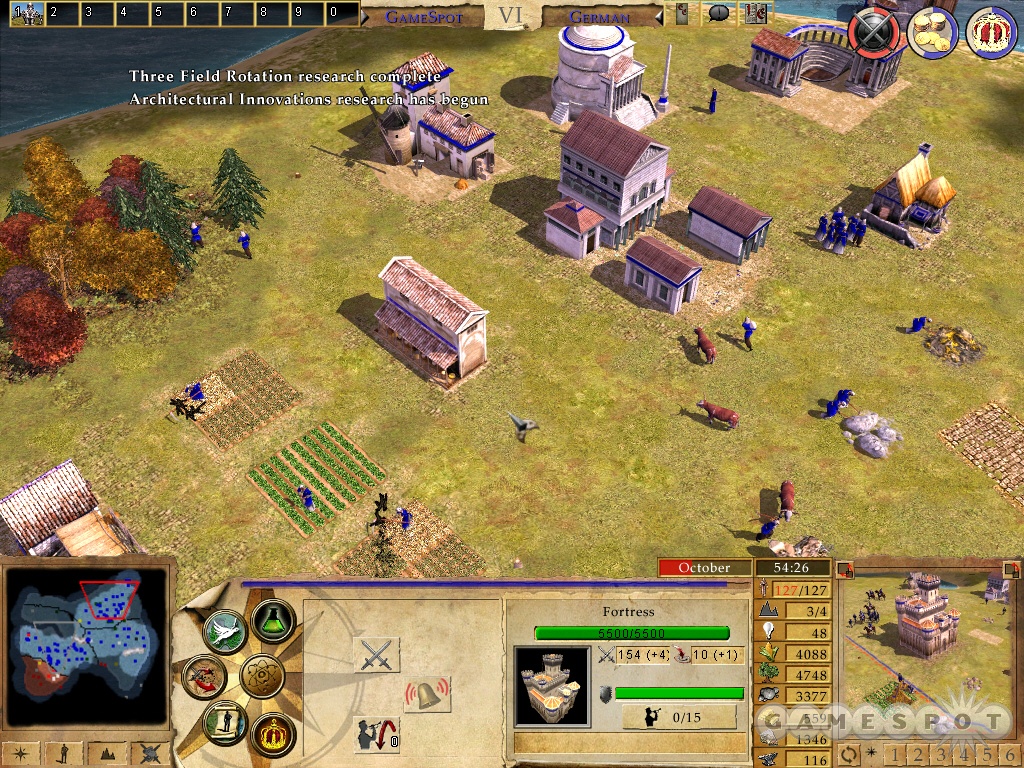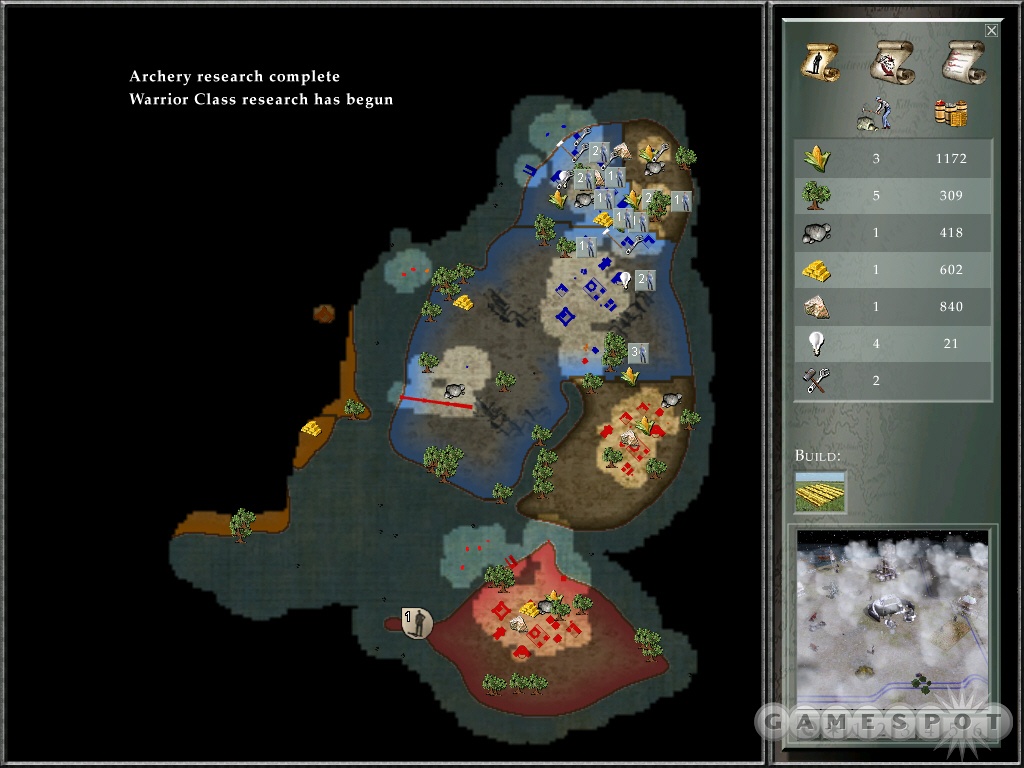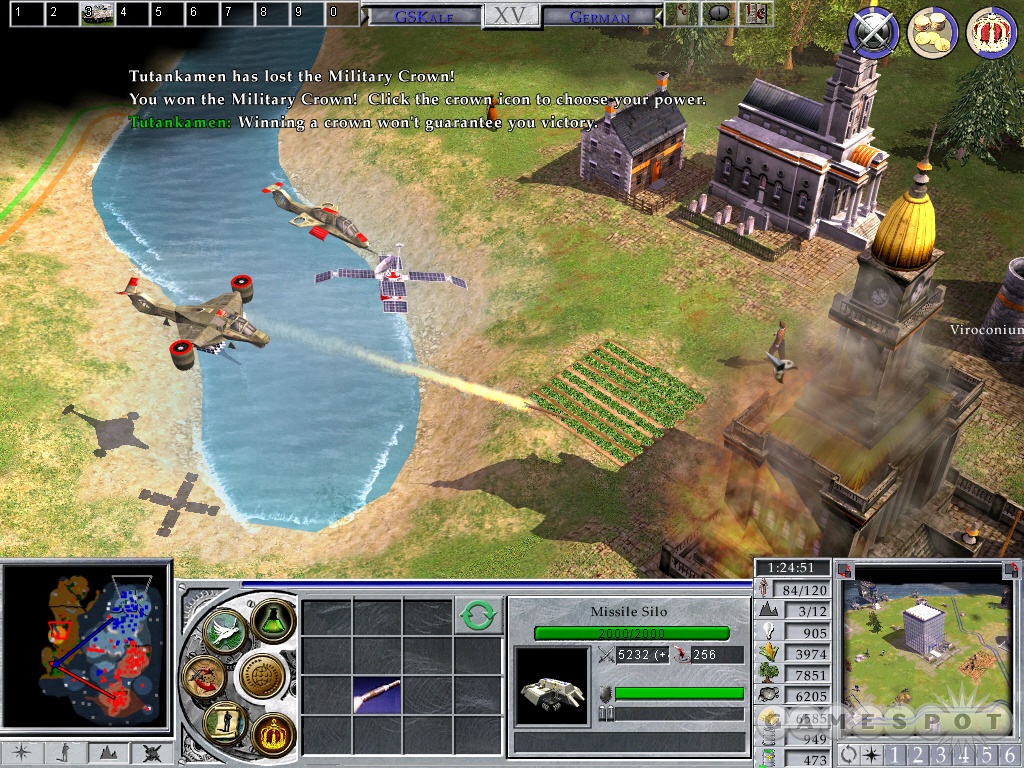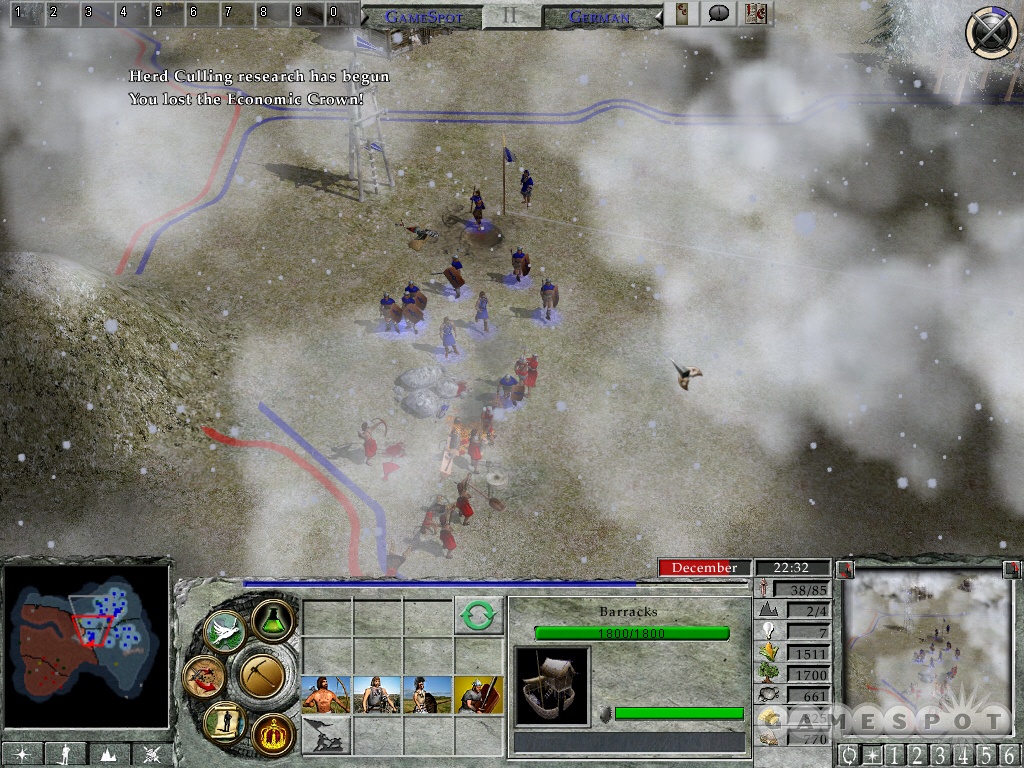Empire Earth II Hands-On
We guide several civilizations from the Stone Age to the Space Age to see how this sequel is shaping up.
2001's Empire Earth is still one of the biggest real-time strategy games we've ever seen. In it, you controlled a civilization from the Stone Age to the Space Age and beyond, all within the space of a few hours. During that span, you explored the world, settled it, and then raised armies and waged war against your neighbors in the ruthless quest for survival and dominance. Now, Vivendi Universal Games is readying a sequel, and we recently had a chance to check it out. Judging from the time we've spent with it, Empire Earth II looks to be every bit as epic as its predecessor. It should be noted, however, that Empire Earth II isn't just a simple follow-up. Mad Doc Software, the company that inherited development duties from creator Stainless Steel, essentially started the game from scratch. As a result, Empire Earth II promises to be a whole new game.

The premise hasn't changed much, though. Your goal is to take a fledgling civilization and guide it from the dawn of history to the future. You can choose from one of 14 civilizations, including the Americans, Germans, Romans, Greeks, Turks, Egyptians, Chinese, and Koreans. Each civilization not only has its own unique units and special bonuses, but also regional bonuses that are shared by similar civilizations. For example, the Japanese get faster fighters and fighter-bombers as one civilization-specific bonus. And since the Japanese belong to the Far-Eastern Region, along with the Chinese and Koreans, those civilizations get regional bonuses that they all share, such as having city centers with 25 percent more capacity. (At this point, we should note that we played with a beta version of the game, and all specific details are subject to change based on play-balancing.)
In terms of single-player gameplay, you have a couple of options available. The first is the campaign. There are actually three different campaigns. The first is set in ancient Korea, where you must defeat the bandits that infest the peninsula and then unify the tribes. The second covers the German civilization from the depths of the Dark Ages to the formation of the modern German state in 1871. The final campaign deals with America's rise as a global power. It begins with the Spanish-American War of 1898 and ends well into the future. Your second option deals with the conventional skirmish game, where you can set up your own custom match. There are oodles of different settings available in the setup screen, and you can choose which civilizations you want to involve, what sort of game to play, and the various different rules and options you'd like to adhere to. Some of the modes will certainly be familiar to you if you're a fan of real-time strategy, like conquest, capitols (which involves knocking out an opposing player by conquering his or her capitol), and regicide (which involves killing the other player's king while at the same time protecting your own).

When you start the game, you'll be presented with the familiar task of having to gather resources, explore the map, and expand your base. There are numerous resources available, including food, wood, and gold. There are other resources that come and go depending on the age. Early in the game, tin is important, because it can be used to create bronze. However, by the Middle Ages, tin is replaced by iron, which is used for steel. Finally, near the end of the game, oil, the lifeblood of modern civilization, and uranium, which has its obvious uses, make an apperance. This can create a situation where you're doing incredibly well in one age, but after you level up, you soon discover that you lack the new critical resource. Meanwhile, it's incredibly easy to gather resources. All you have to do is click on the resource in question in the bar at the bottom corner of the screen. Mouse over a specific resource, and the game tells you how many citizens are currently gathering it and how many citizens are idle. You simply left-click to assign an idle citizen to collect that specific resource, while you simply right-click to unassign a citizen from collecting that specific resource. This lets you quickly respond to shortages and surpluses without taking your focus off combat.
Tech Is King
Your most critical resource, though, are tech points. To purchase technology upgrades and to advance to the next epoch, you need to amass tech points. You can only do this by building and garrisoning certain structures, such as universities and temples. Doing so will slowly begin to accumulate tech points for you. During the early stages of the game, you'll need about eight tech points to purchase a technology on the tech tree. These technologies include fire-hardened weapons, which let your macemen and swordsmen inflict more damage, and dried-timber construction, which gives your city center more hit points and a greater line of sight. Each epoch has 12 different technologies that you can research, which are divided into military, economic, and imperial lines. Be the first civilization to research all the technologies in one of these lines and you'll gain a special crown, which lets you choose a special temporary power as a reward. Earn the military crown, for example, and you can select infantry doctrine, which makes your infantry more powerful. Or if you earn the economic crown, you can temporarily boost your economy to a war footing, allowing you to produce more units.

It gets interesting when, to advance to the next epoch, you have to research at least six of these technologies. So you're presented with something of a quandary. Do you spend your time researching all the technologies in an epoch to gain a crown? Or do you forgo certain technologies, and the hope of a crown, to level up faster? It's something of a coin flip, because you can gain access to slightly more-powerful units by leveling up, or you can toughen up your existing units by researching all the available technologies. There are approximately 15 major epochs, or ages, and each unlocks new units, technologies, and even buildings.
Another key factor to consider is territory. Each map is divided into preset territories, each with its own resources. You can only build one city center, university, and temple per territory, so, obviously, the more territories you control, the more tech centers you can construct...and the faster you can level up. This means you'll have to be wary of anyone gaining multiple territories. If someone does, you may find it necessary to use the diplomacy screen to look for allies so you can take down that opponent before he gets too much of an edge. (In one multiplayer game we played, the human players partnered against the computer players, and we were able to reach the late epochs of the game while the computer was still stuck in the Middle Ages. Needless to say, it was fun sending orbital and nuclear bombers against the computer's medieval cities.) If you do ally with someone, you can use the war-planning screen to coordinate the movement of your troops. Simply draw arrows on the map indicating where you want your ally to attack, and he will see those arrows on his minimap. You can also use the war planner to give direction to your troops so they'll automatically head off for the front.

Combat can be very chaotic, simply because there can be a huge population limit in the game. It's not too surprising to see plenty of swordsmen, cavalry, and catapults headed your way early on. There's a huge variety of units covering all the different eras of history as well. Warriors and barbarians give way to swordsmen and spearmen, who give way to infantry. Meanwhile, naval and air combat become important in the later stages of the game, thus adding to the fireworks. There are also spies and priests to play with as well, and you can use the latter to convert other units to your side.
From our brief time with the game, it's clear this is every bit an epic-scale real-time strategy offering as the original. Still, from our experience so far, you'll probably be able to tackle a game within an hour or two. Empire Earth II certainly holds a lot of promise and potential, but we'll need to see how all these different civilizations, units, and technologies balance out. We'll find out this spring, when the game is scheduled to ship.
Got a news tip or want to contact us directly? Email news@gamespot.com
Join the conversation